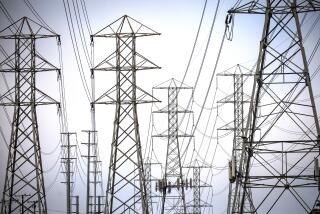A Way to Stop Leaks: ‘Super-Weatherizing’
- Share via
Of all the energy-saving techniques for residences that have sprung up in recent years, the one that is perhaps the least known, but most effective, is “super-weatherizing,” an approach long used by the military to save money on the heating and cooling of barracks.
The technique involves testing for drafts and leaks using a powerful fan that sucks air through a home as a technician uses a “smoke wand” to check for drafts and leaks. Leaks are found when the meandering smoke veers toward the fan. Typically, leaks occur along baseboards, plumbing leading into walls, ductwork, electrical outlets and badly sealed doors and windows.
By contrast, Southern California Edison Co. conducts “energy audits” of homes without ever setting foot inside them. Residents are asked a number of questions, such as whether they have wrapped their water heater with an insulator blanket, or whether there is insulation in the attic. They are advised to buy the missing items and can qualify for rebates.
Far From Effective
Such arms-length techniques are far from effective, according to energy expert Amory Lovins, because they do not detect unseen leaks that force residents to repeatedly reheat or recool new air constantly entering the home.
“All cities leak like sieves, and there’s simply no reason for it,” Lovins said. “We could cut electricity use in this country by three-quarters, and we know how to do it right now.”
Under a little-publicized program supported by the Federal National Mortgage Assn. (Fannie Mae), potential home buyers can apply for extra money in their mortgage loans to pay for “super-weatherizing” them. Hundreds of homes in Southern California have been weatherized this way at a cost of about $2,500 to $3,500 each, with a typical pay-back of about three years. After that, the homeowner enjoyes permanent and dramatic savings.
Ray Hall, owner of H&L; Energy Savers Inc. in Upland, which sells “super-weatherizing,” said home buyers find that the extra debt adds about $20 to $30 to their monthly mortgage, but the typical home immediately saves $40 to $50 a month on heating and cooling costs.
Can Save Tremendously
“How long are people in Southern California going to pour a $100 bottle of Champagne into a glass with 50 holes in it?” Hall asked. “People say you only need that in Maine or Pennsylvania--but people can save tremendously on air conditioning and on heat, so you benefit during two different seasons.”
A “super-weatherized” house, which includes wall and attic insulation, allows its entire air volume to be exchanged, through normal leakage, once every two hours. The Environmental Protection Agency considers that movement of air sufficient to avoid indoor pollution.
Most homes in Southern California, Hall said, typically lose a houseful of air more than once each hour--the equivalent of having a window open at all times. Worse, during a 20-m.p.h. wind, most homes lose about 15 to 20 housefuls of air each hour.
Although the utility companies do not offer rebates for “super-weatherizing,” the technique has been endorsed by Century 21, a real estate firm, which is promoting the mortgage loans in a brochure developed with Hall. THROUGH THE ROOF Where a typical Southern California house leaks energy year-round (heated or cooled air): Non-insulated attic 15% Non-insulated walls 20-30% Non-insulated floors 20-30% Windows 15% Gaps and leaks * 40% to 50%
* Gaps and leaks, which are difficult to detect without a special smoke wand and wind generator, are the most significant source of energy loss. They most often include poorly sealed baseboards and attic hatches, plumbing openings in walls, ductwork rips and cracks, electrical outlet gaps, poorly closing fireplace dampers and brickwork gaps, and ill-fitting doors and windows.
Source: U.S. Department of Energy
More to Read
Inside the business of entertainment
The Wide Shot brings you news, analysis and insights on everything from streaming wars to production — and what it all means for the future.
You may occasionally receive promotional content from the Los Angeles Times.










